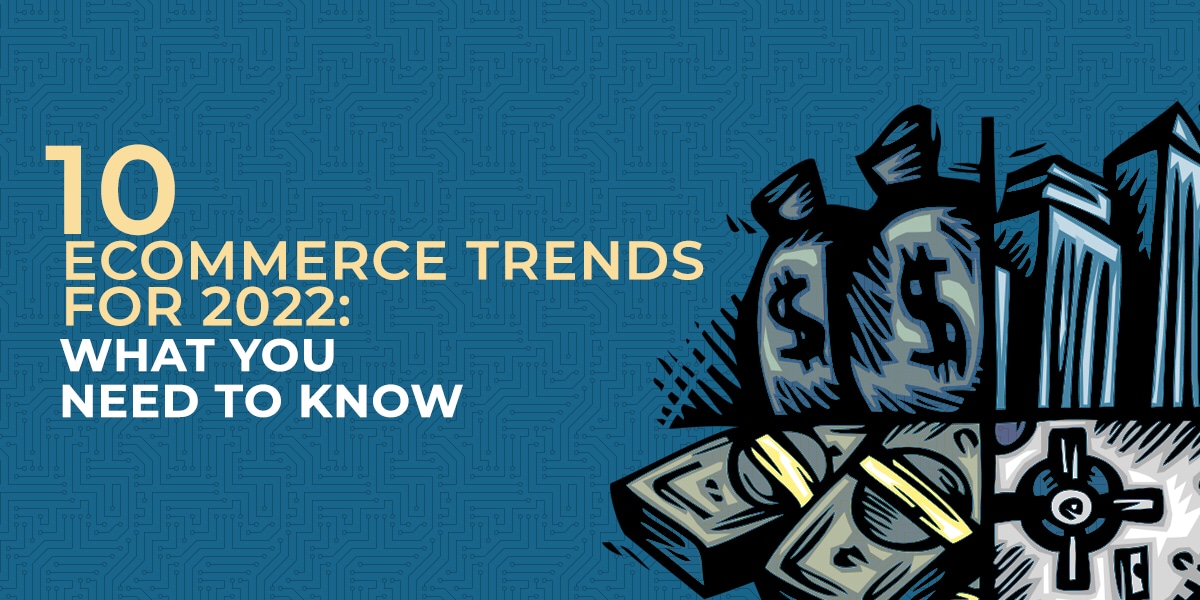10 eCommerce Trends for 2022: What You Need to Know
When it comes to the internet, the best way to do business can change at the drop of a hat. Now more than ever, it’s important to stay on top of trends to maintain relevance in a competitive landscape.
People of all ages shop online, so you have to be on top of current eCommerce trends to ensure you don’t fall behind. If boomers can figure out how to use a computer, your business can figure out how to optimize your eCommerce site too.
Keep reading for the new eCommerce trends for 2022.
Why Staying Up-to-Date on New eCommerce Trends is Important for Your Business
Now that literally any product or service is available with the click of a button, people won’t waste their time figuring out a wonky website. If any aspect of your eCommerce site doesn’t have what a customer needs, they will get frustrated and go somewhere else.
With endless online shopping options to choose from, you have to be on top of your game to get consumers’ business and keep them coming back to your site
By staying up to date on these 10 eCommerce trends, you’ll be headed in the right direction to maintaining customer satisfaction and finding loyal customers.
If the idea of following current eCommerce trends is overwhelming, you can look into professional digital marketing services to help.
Keep reading to see the top eCommerce trends for this year.
1. Subscriptions and Loyalty Programs
Subscriptions can take a variety of forms. They could be a book box that people get once a month full of limited edition items, or they could be memberships that give people extra discounts or early access to big sales. These exclusive benefits in a subscription help you, secure long-term customers.
Similarly, loyalty programs are more like a modern-day punch card: when customers purchase from you over and over again, they can be rewarded with points they can later use to receive discounts or free items. A loyalty program encourages people to make purchases they might not have otherwise because they’ll save money in the long run.
2. Voice Search
Voice search is so common that people are doing it everywhere they go. Plus, voice eCommerce sales are expected to reach 19.4 billion in 2023, so you should implement it on your site now. Voice search will make it easier for your customers to make purchases and also allows you to interact with them in real-time.
You need to ensure that your site is equipped to handle voice search so your customers can maneuver through it with whatever smart hub they prefer (Siri, Alexa, etc.).
3. Multichannel Customer Experience and Support
People shop on many different devices: phones, laptops, tablets, and even gaming systems. They need the same shopping experience on every platform that they are using, so they can go between devices to shop for the items they are looking for in their cart.
Not everyone wants to contact customer support the same way. You are going to be an introvert’s best friend if you offer a chat-box option with live customer support. Others will want to talk to a real person on the phone. By offering many different options for customer support, you’re able to satisfy your buyer’s needs and earn their trust.
4. Mobile Shopping Tools
Mobile commerce is expected to double by 2025 because everyone wants to be able to shop on their phone. Because there are many mobile eCommerce options, all you need is a mobile-optimized website. You can have a full desktop version, but also create a mobile experience that streamlines options to make your site easy to use on a phone.
If you want to go above and beyond, you can set up your own app. However, not everyone wants to download an app just to shop, so consider your audience first before investing in app development.
5. Diverse Payment Options
There are tons of different ways to pay for a good or service, including PayPal, Zelle, credit cards, and more.. The more payment options you have on your site, the better. Some people will want to save their credit card for future use on your site, while others will prefer a more anonymous, secure payment method like Paypal.
Also, consider investing in one-click payment methods. People want to shorten the shopping experience as much as possible, especially if they are using a phone, and one-click payment methods entice them to buy your product right then.
6. Highly Optimized Websites
With customer data readily available, you can optimize your website to their preferences. Nothing is too small: factor in font, font size, page layout, and all other little details. Use A-B testing with your marketing team to ensure what works best, and update it as needed.
7. Selling Through New Channels (like Amazon)
If you need to expand your eCommerce, try selling through a new channel. It’s easy to set up an Amazon marketplace account, so you could add that as an option to your current website. Plus, if you sell through Amazon, you can look into offering Prime shipping. This could encourage a Prime member to purchase one of your products when they wouldn’t have otherwise. You can use Amazon to extend your reach, but maintain the quality and brand experience on your business’s website.
8. Personalized Products and Marketing
It’s easy to personalize your marketing strategy, and people notice when you go the extra mile to do so. Offer search suggestions like products similar to one that your clients are looking for. Use smart website features, personalized pop-ups, follow-up emails, and deals for your email newsletter subscribers.
9. Focus on Sustainability
Due to increased public concern about climate change, consumers have begun to care more about purchasing sustainable products. 57% of people plan to buy from a brand that values sustainable practices and uses sustainable materials. If you want to keep your customers for the long haul, investing in sustainable practices will bring people back to buy from your company again and again.
Some easy sustainable practices you can implement are:
- Recyclable shipping materials
- Slower shipping options that use fewer greenhouse gasses (and note that it’s green in your check-out options!)
- Update existing products with more sustainable materials
10. High Online Advertising Competition
Budget more for your advertising. As more businesses add eCommerce options, it’s going to get more expensive to run your ads. By planning your budget now for rising advertising prices, you’ll be able to stay ahead of the game.
How You Can Capitalize On New Trends to Improve Your eCommerce Business
Capitalizing on these new eCommerce trends looks different for every business out there. To know what will work best for your business, you may need some professional help. Contact N2Q to learn more about how you can capitalize on these trends to improve your business in 2022.
E-Commerce No To The Quo



